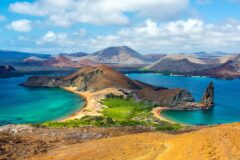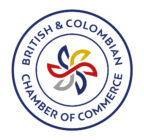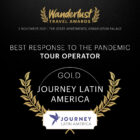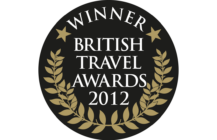
Overview & Highlights
A well priced holiday where you visit two of Latin America’s top highlights: the wildlife rich Galápagos Islands off the coast of Ecuador and Machu Picchu and Cusco, Peru’s biggest stars.
- 4 night cruise around the Galápagos Islands
- Half day Colonial Lima and Larco Museum visit
- Half day city tour of Cusco and visit Sacsayhuamán Inca fortress ruins
- Full day excursion to the Sacred Valley of the Incas
- Guided tour of Machu Picchu ruins
A comprehensive well-priced holiday combining a Galápagos cruise with colonial Quito and the best of Peru: Machu Picchu, Cusco, and the Sacred Valley of the Incas.
This two-week holiday is packed with highlights: you won’t believe you’ve managed to see and do so much. Arriving in Quito, Ecuador, you are whisked off to your hotel right on the historic main square of the colonial heart of this Andean city, and have a day to explore. Then you fly off to the Galápagos Islands, 1000km off the coast but only a couple of hours by air: what a difference though, you are now basking in the tropical sunlight of this enchanting volcanic archipelago.
Board a friendly, good-value motor yacht for a five-day cruise exploring the islands; viewing its extraordinary inland, shore and marine wildlife from a hiking trail, an inflatable boat, or your snorkel. After this, you fly down to Peru to visit the continent’s top sights: Machu Picchu and Cusco, cultural icons in a gorgeous highland setting.
Outline itinerary
Day 1
Arrive in Quito, Ecuador, transfer to hotel in historic centre
Day 2
At leisure to explore the capital city.
Day 3
Fly to the Galápagos islands; board your expedition vessel.
Day 4
Visit Punta Cormorant and Post Office Bay (Floreana).
Day 5
Drop anchor at Gardner Bay; continue to Punta Suárez (Española).
Day 6
Explore Punta Pitt and Cerro Brujo (San Cristóbal).
Day 7
Visit Isla Lobos. Disembark and transfer to San Cristobal airport, fly to Lima, Peru.
Day 8
Colonial Lima Tour and Larco Museum; fly to Cusco.
Day 9
City tour of Cusco and nearby Inca sites.
Day 10
Guided tour of the Sacred Valley of the Incas.
Day 11
By train to Machu Picchu; guided tour of the site.
Day 12
Optional revisit to Machu Picchu; Return to Cusco.
Day 13
Fly to Lima and connect with international flight.
Itinerary
Day 1
Arrive in Quito, Ecuador, transfer to hotel in historic centre
The active volcano Guagua Pichincha glowers over the dynamic city which, at 2,850m, is one of highest capital cities in the world. Quito is divided into two contrasting districts. The modern zone is characterised by towering glass buildings and houses banks, international companies, hotels, shops and restaurants, while the central colonial area has well-conserved and recently spruced-up white-washed architecture, open air markets and graceful Spanish-style mansions and churches.

Day 2
At leisure to explore the capital city.
Quito was the first city ever to be named a World Heritage site. We suggest you take your time to stroll around the historic core, which starts right outside your hotel. High on the agenda is a walk through the main plaza, the Plaza de Independencia, where you will see the government palace, the cathedral, and some of the most important churches built around the 16th and 17th centuries, including the monastery of San Francisco.
You might also head off to look at the buzzing modern sector, look round the shops, pop into a bar or have an evening meal.

Day 3
Fly to the Galápagos islands; board your expedition vessel.
Drive from Baltra to Puerto Ayora on Santa Cruz Island, the largest town and port in the archipelago. Visit the nearby Charles Darwin Research Centre, a biological centre for the study and conservation of numerous species of Galápagos flora and fauna operated by the Charles Darwin Foundation. Later head through farmland into the lushly vegetated highlands of Santa Cruz where you will explore one of the ranches where the iconic giant tortoises can be seen in the wild. After the visit, return to Puerto Ayora to board your vessel.

Day 4
Visit Punta Cormorant and Post Office Bay (Floreana).
Floreana Island is probably best known for its colourful history involving buccaneers, pirates, whalers, convicts and later, colonists. In 1793, British whalers established the Post Office Barrel as a means of sending letters to and from England. This goodwill tradition has been upheld over the years, and even today visitors may drop off and pick up letters, without stamps, to be carried to faraway destinations.
Before dropping anchor at Post Office Bay you will visit Punta Cormorant, where pink flamingos dot the still waters of a bright lagoon and a white-sand beach provides the nesting ground for sea turtles (December to May). You also have the opportunity to snorkel off Champion Islet, one of the prime snorkelling sites of the archipelago offering underwater encounters with sea-lions, a dazzling array of tropical fish and penguins torpedoing just below the surface.

Day 5
Drop anchor at Gardner Bay; continue to Punta Suárez (Española).
Española Island is the most southerly in the archipelago, and reputedly one of the oldest – it was created by volcanic action up to three and five million years ago. At Gardner Bay there is a beach inhabited by sea lions and mockingbirds. Gardner and Osborn islets just off the coast are excellent for snorkelling. From Punta Suárez you can stroll along trails over lava rocks dotted with the nests of blue-footed boobies, waved albatross marine iguana that are endemic to the island. There is also a blowhole which forces water 30m up into the air – an impressive sight.

Day 6
Explore Punta Pitt and Cerro Brujo (San Cristóbal).
Punta Pitt is on the north eastern tip of San Cristóbal Island where endemic species include lava lizards, Chatham mockingbird and red-footed boobies. One of the oldest islands in the archipelago San Cristóbal is characterised by its eroded volcanic peaks in the north and densely vegetated slopes in the south. Cerro Brujo is a volcanic crater with very interesting lava formations. It has a white coral beach and a great open walking area with rewarding bird-watching.

Day 7
Visit Isla Lobos. Disembark and transfer to San Cristobal airport, fly to Lima, Peru.
As its name suggests Lobos islet is smothered with sea-lions frolicking on the rocks, their playful, ungainly movement accompanied by a cacophony of wailing. There is a nesting site for blue-footed boobies for you to investigate and you can snorkel here too. Transfer to San Cristóbal for your flight back to the mainland and connect with your flight to Lima. Transfer to your hotel in the Peruvian capital.

Day 8
Colonial Lima Tour and Larco Museum; fly to Cusco.
Lima is a vast, complex metropolis, with a history dating from the era of its wealth and importance to Imperial Spain to its current status as a dynamic, growing city of trade, industry and tourism.
Plaza San Martín, with its colonial churches, promenades and palaces marks the beginning of a guided tour that unearths much of the country’s turbulent past. En route, visit several palaces including the Torre Eagle Palace (built for the treasurer of the Royal Spanish fleet and considered to be the most striking of Lima’s 18th century mansions). Another building which borrows its architectural style from Baroque and Moorish Spain is the Monastery of San Francisco with its fascinating library and catacombs.
The final port of call is the private Larco Museum with its collection of beautifully modelled pottery, unique gold and silver work, mummies, and ceramics from pre-Inca civilisations. Afterwards, you will continue to Lima airport where you will board your flight up into the Andes to Cusco. Your accommodation is in a homely hotel established to support Cusco’s street children.

Day 9
City tour of Cusco and nearby Inca sites.
Cusco, the former capital of the Inca Empire, is a fascinating mix of colonial churches, monasteries and convents, alongside extensive pre-Columbian ruins. Almost every central street has remnants of Inca walls and much of this ancient stonework now serves as foundations for more modern dwellings.
Your guided tour explores the magnificent main square with the 16th century cathedral and the church of Santo Domingo – built on the site of Qoricancha, Cusco’s major Inca temple.
Overlooking the city on the northern outskirts of Cusco lie the ruins of Sacsayhuamán, believed to have been both a fortress and ceremonial centre. The site has some magnificent Inca walls immaculately constructed from massive rocks. The visit also includes the nearby ruins of Inca staging post Tambo Machay, with its ceremonial fountains and bath, the military fort Puka Pukara and the temple of Q’enko with its sacrificial stone.

Day 10
Guided tour of the Sacred Valley of the Incas.
Lying just a few kilometres from Cusco, the Sacred Valley of the Incas was once the bread-basket of the Inca empire, heavily populated in imperial times and scores of archaeological sites remain, where well-preserved ruins bear witness to the highly developed society that the Incas created.
The drive takes in several of the villages and temple fortresses that pepper the valley. You visit Pisaq, both the village, and the terraces and fort high above. The engineering and preservation are unrivalled.
From the flat valley floor the sculpted hillside rises up like a green staircase to the heavens. Continue along this picturesque, patchwork valley to the fortress/temple of Ollantaytambo where snow-capped Andean cordillera forms a stunning backdrop.
The fortress, the colonial grid plan and the Inca foundations are still intact and there are wonderful views down over the sloping hillsides and into the fertile valley. You’ll be spending the night in a homely hotel here.

Day 11
By train to Machu Picchu; guided tour of the site.
Transfer to Ollantaytambo, train to Machu Picchu, guided tour of the ruins, overnight.
Travelling for 90mins by train from Ollantaytambo, you reach the ruins of Machu Picchu. As the river Urubamba enters its narrow gorge between thickly-forested granite hills, there is room only for a single track, which hugs the right bank and passes through hamlets that are no more than a collection of shacks beside the railway. Close to the foot of the mountain on a saddle of which the citadel was built is the village of Machu Picchu, dedicated to serving the many visitors with artisan markets, bars and restaurants.
The majestic ruined city, reclaimed from tropical cloud forest, is reached by bus up a sinuous road, or on foot up a near vertical rocky path. The American explorer Hiram Bingham discovered it in 1911, by which time it was completely buried beneath jungle vegetation. It is perhaps the ruins’ location, on a ridge spur amid forested peaks and above a roaring river canyon, that most ignites the imagination.
You will have a guided tour of the ruins along one of the set trails, before heading back down to spend the night in Machu Picchu village.

Day 12
Optional revisit to Machu Picchu; Return to Cusco.
Train times permitting, there’s the opportunity to return to the site of Machu Picchu. Getting up early and taking one of the first buses up to the site is well worth it. The ruins are virtually empty at that time and the early morning mists swirl around the surrounding mountain tops.
There is time for an optional hike to the summit of Huayna Picchu (although this must be booked in advance). Alternatively enjoy the thermal baths or walks in the village below. Later, travel to Cusco by rail and road, taking about 4 hours.

Day 13
Fly to Lima and connect with international flight.
At Lima airport, connect with your international flight; or continue with an extension to your holiday.
Essentials
Tour info
Transport
5 flights (longest 2.5hrs); 2 rail and road journeys (longest 4hrs).
Accommodation
This holiday incorporates simple, economical mid-range hotels, some with plenty of history and special features. Archipel is a small, good value motor catamaran with a dazzling white and blue contemporary décor with polished wood, lending her a genuine nautical feel.
Meals
Breakfast daily, full board days 3-6.
Guides
We carefully select our local partners, some of whom we have worked with for over 25 years. Their English-speaking guides understand the expectations of our clients very well, and are consistently singled out for praise by the latter on their return.
Summary Of Nights
13 days, 12 nights: Quito 2; Galápagos 4; Cusco 2; Sacred Valley 1; Machu Picchu 1; Cusco 1; Lima 1.
Currency
The unit of currency in Ecuador and the Galápagos is the US dollar; in Peru is the sol.
How To Take It
Cash machines are available in all major cities and towns, and so taking a debit or credit card with a PIN number is the most convenient way of withdrawing money while on your trip, and in most shops and restaurants you can also pay by card. However, since cards can get lost, damaged, withheld or blocked, you should not rely exclusively on a card to access funds.
We recommend that additionally you take a reasonable quantity of US dollars cash (no more than is covered by your insurance), which you can exchange into local currency in Peru, and use in Ecuador and the Galápagos where the dollar is the national currency. Dollar bills should be in good condition, soiled or torn bills may be refused. You can take sterling, but the exchange rate is not always competitive or even available, restricting the number of places where you can change money.
Daily Spend
It is very difficult to give a guideline for essential expenses but a budget of around US$35-$45 per day should cover the cost drinks and the odd souvenir, and of decent quality meals on those days in the holiday itinerary when not on the cruise. Eat at the very best restaurants and you will pay considerably more.
Tipping
Tips are welcomed and local guides often rely on their tip as a significant proportion of their income.
Most service industry workers will expect a tip of some kind and so it is useful to have spare change for hotel porters, taxi drivers and the like. It is common to leave 10 – 12% in restaurants. On the cruise, you might consider a tip of $15-20pp per day for the crew and $8-10pp per day for the guide.
Tipping guidelines can be found in our Briefing Dossier.
Insurance
Travel insurance is essential. Details of our recommended policy can be found on our Travel Insurance page.
Given the limited medical facilities in the Galápagos Islands and the costs related to air ambulance services, you are strongly encouraged to obtain travel insurance which includes air ambulance services.
Airport Taxes
If you have purchased your flights through Journey Latin America, the international departure tax is usually included in the ticket.
Visas
Holders of a full British passport do not require a visa, although passports must be valid for at least 6 months after the trip begins. Anyone with a different nationality should enquire with us or check with the relevant consulate.
If flying to the US, or via the US you will need to fill in your online ESTA application.
Trip Suitability
This holiday is suitable for all able, reasonably fit visitors. The sea can be choppy around the Galápagos islands.
Climate
In the Galápagos, from January to April it’s hot and the sun is relentless, with some sudden showers. May to July, and October to December is cloudier; August and September it’s often cloudy and cool, and a stiff breeze makes the waters choppier. High and Low seasons reflect demand rather than the best time to go. Many boats are in dry dock in September.
The rainy season in the Andes runs between November and March when there are showers most afternoons. The dry season is in June, July and August when the sun is strong during the day, but at night the temperature drops dramatically (from freezing point to 10°C). May, September and October are less predictable, with both rainy and sunny spells.
Lima is covered in a dull grey mist for much of the year, although the sun does break through between November and March. It almost never rains in Lima, and temperatures are moderate.
In Cusco and the highlands, June to September can be very cold at night, but days are usually extremely clear with sun. November to April are the wettest months of the year – note that rains tend to be in short, heavy bursts, rather than continual showers, with rains clearing towards the end of April. Nights are cold throughout the year at altitude.
Altitude
Your stay in Cusco y is at high altitude (3,300m). A small minority of visitors may suffer temporarily from altitude sickness. Symptoms vary; most common are mild headaches, slight nausea and breathlessness. If you don’t recover in a day or two speak to our representatives; in very rare instances it is necessary to descend to lower altitudes. Most people are unaffected and if you drink plenty of water and allow your body to acclimatise (don’t exert yourself or drink alcohol) in the first couple of days after arrival, you will minimise your chances of suffering any symptoms.
Please refer to our Briefing Dossier for further information.
Clothing And Special Equipment
For day-to-day wear you should go prepared to encounter all seasons. Both warm clothing and a sun hat are essential at altitude; a light fleece jacket and a waterproof/breathable outer shell makes a good combination. Trousers, skirt or shorts made from light, quick-drying synthetic materials work well. If you plan to eat in smart restaurants, although clothing is not formal (no need for jacket and tie), something quite smart would be appropriate.
Strong, comfortable footwear is essential and you should bring insect repellant, sun block, hat and sun glasses. You should take swimwear for pools and ocean swimming (Galápagos). The ship provides complimentary use of snorkelling equipment and 3mm ‘shorty’ wetsuits but you may prefer to bring your own. Aqua-socks or rubber sandals are useful for embarking and disembarking on wet landings. Bring a light waterproof jacket in case of rain. For June to November departures, the waters can be chilly.
Due to luggage restrictions on the train to Machu Picchu, main luggage must be left in Cusco. You can take up to 10kgs per person on the train and an overnight holdall is recommended to separate your luggage for the night spent away from Cusco.
Please get in touch with the office before departure if you have any doubts. Good equipment is very important and hard to come by in South America and Galápagos.
Vaccinations
Preventative vaccinations are recommended against the following: typhoid; polio; tetanus; hepatitis A. You should consult your GP for specific requirements.
For admission to the Galápagos a yellow fever certificate is required for anyone over 1 year old coming from an area with risk of yellow fever transmission.
You can also find helpful information on the Masta Travel Health website.
What's included in the price
- Services of our team of experts in our London office
- Services of Journey Latin America local representatives and guides
- All land and air transport within Latin America
- Accommodation as specified
- Meals as specified
- Excursions as specified
- Galapagos National Park and Ingala Fee
Included Excursions
- 4 night cruise around the Galápagos Islands
- Half day Colonial Lima and Larco Museum visit
- Half day city tour of Cusco and visit Sacsayhuamán Inca fortress ruins
- Full day excursion to the Sacred Valley of the Incas
- Guided tour of Machu Picchu ruins
What's not included in the price
- Tips and gratuities
- Meals other than specified
- International flights to Latin America
- Airport taxes, when not included in the ticket
- Optional excursions


































